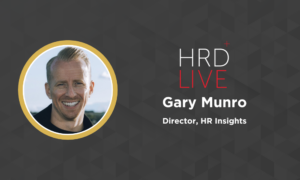How do we improve the employee experience in 2021?
- 10 Min Read
HR leaders Chuck Kemper, Chuck Heaton, Sanjay Harrichand and Jason Anderson explore the top imperatives for improving the employee experience in a post-2020 world
- Author: Chuck Kemper
- Date published: Jul 14, 2021
- Categories

The world’s axis tilted, the paradigm morphed, and it’s been cataclysmic. According to Forbes, “Many venture capitalists and technology entrepreneurs are predicting a permanent radical transformation of how people work”1. So, surely what people need in order to do their best work (e.g. elements of being highly engaged) has radically changed too? What are they key priorities of the employee experience?
Let’s first look at what an engaged employee looks like. Combining the research of the Gallup Organisation, Corporate Executive Board, Kenexa and Korn Ferry, Ashley Goodall and Marcus Buckingham2 proposed that the extent to which someone agrees with the following eight statements is the degree to which one is engaged3:
- I am really enthusiastic about the mission of my company (we)
- At work, I clearly understand what is expected of me (me)
- In my team, I am surrounded by people who share my values (we)
- I have the chance to use my strengths every day at work (me)
- My teammates have my back (we)
- I know I will be recognised for excellent work (me)
- I have great confidence in my company’s future (we)
- In my work, I am always challenged to grow (me)
These eight are the result of decades of research across tens of millions of data points demonstrating engagement’s correlation to organisational performance.
Satisfaction versus dissatisfaction?
When we talk engagement, we are not talking about satisfaction versus dissatisfaction. We are talking about creating an environment, mostly through one’s manager, in which they give willingly to their work at a visceral level because they feel self-actualised by it. Whereas, with satisfaction, one can be satisfied but nowhere near the zone of full engagement.
In fact, one could be dissatisfied with extrinsic job factors, like the nature of the workspace, the commute, and even pay, but still be highly engaged; this can be attributed to effective leaders who set clear expectations (#2 above) and assigned work which plays to one’s strengths (#4 above).
Of course, extrinsic factors leading to dissatisfaction can overtake one’s engagement if they are bad enough, like being told your job could be cut. However, if the opposite were not also true, that one’s engagement can outweigh the dissatisfying factors, many companies would collapse and volunteerism would disappear.
Our goal then should be doing both: driving out dissatisfaction and driving up engagement; two different spectrums of the employee experience and both addressable.
Changes witnessed in recent times
On to 2021. The fundamentals of the employee experience have not changed because of 2020. The degree to which people feel aligned with the eight statements above will still determine your team’s productivity, customer relations, safety, contribution to profit and shareholder return, absenteeism, and voluntary turnover.
However, when we peruse the list of eight above, we do not find remote work, virus protocols and wellness, or DE&I programming, and yet these issues have weighed on leaders trying to engage their employees of late.
So, do I as a leader need to worry about these if I want to engage my team? Short answer, yes. While those efforts may not increase engagement, a shortfall in flexible work policy, wellness or DE&I strategy may leave you without a team to manage.
In the first half of 2021 we saw a dramatic increase in desire to change jobs and in resignations. Prudential’s Pulse of the American Worker Survey conducted in March found 26% overall and 34% of millennials plan to look for a new job.
80% of these are concerned about career growth. A similar survey in February by the Achievers Workforce Institute found 52% of respondents plan to look for a new job. Plus, the US Labour Department shared that Americans are resigning more frequently than at any time in the last 20 years. In April the pace was 2.7%, a huge leap from 1.6% a year prior.
Defining new priorities
This begs the question: what has changed?
Wellbeing – Get accustomed to it, but make sure you define it first; mental health, physical health, and financial health are key. A recent study by Gympass found 77% think that it is “somewhat” to “very” important that their employer provide affordable wellness options. However, the number of companies that helped with wellness during the lockdown was only 34%.
Wellbeing around mental health may not rebound just because lockdowns are over and the risk to one’s health is seen to be diminishing. Studies by the Nuffield Foundation showed that the negative psychological effects of SARS and Ebola lasted up to 3 years after the event.
Recognise that a corporate wellbeing program, such as on-call confidential counselling, is never going to boost engagement, but without addressing this extrinsic factor, you will send a message that you do not care and/or that you are not willing to pay for competitive benefits. It must not be ignored.
However, when it comes to mental wellbeing, improving the way you address it in the supervisor-subordinate relationship absolutely does have the potential to increase engagement.
A people leader skilled in this area will competently focus people on their strengths in tough times, challenge people to grow through adversity, and ensure struggling team members are supported; all factors that lift engagement. Here is some skill building that can take you beyond meeting a wellness need and into the zone of high engagement:
- Train people leaders in identifying mental health issues and to lose their bias around it
- Teach these leaders to strengthen their EQ and how to coach for resilience
- Have an overall mental health strategy: The HR playbook for mental health
Flexible work – An Accenture poll of 9,000 workers found 83% viewed a hybrid workplace as optimal, but remote work has dark sides too. Nearly half of the employees in the Prudential survey expressed disconnection from their companies after a year of working remotely. Additionally, there is burnout by those who cannot break away from work when there is no commute to draw a line in the day.
Many CEOs feel strongly that lack of people in common workspaces has damaged collaboration, trust and/or innovation. The combination of remote work facilitating organisational detachment, as well as access to an exponentially larger job market, is a huge driver of the interest in leaving one’s current employer. Decide your policy carefully among the limitless possibilities of hybrid, remote, designated days/blocks, flex, etc., and make it one that allows leaders to lead.
Do not count on it improving the level of engagement, but rather driving out the potential for dissatisfaction and the ensuing exodus. The key is to create an approach where:
- Employees feel trusted – value productivity and quality of results rather than strictly time spent
- Employees feel connected – foster socialisation
- Nothing is lost on innovation, collaboration and trust – be intentional in scheduling and facilitation of highly interdependent work including the tools for such; perhaps design in time blocks where all staff are expected to be in the office
While you are at it, give consideration to those folks who do jobs that cannot be done remotely and the potential of creating a bigger divide between the two.
Diversity, equity & inclusion – It can have countless forms but it cannot have no form, not anymore. You have to decide what is for your organisation and make it material to creating a sense of belonging.
Perhaps it is committing to unconscious bias awareness training for the board level down to the frontline supervisors, making a change to your leadership development programmes to teach inclusion skills, or launching affinity groups targeting professional growth.
Are you going to get higher levels of engagement and the correlated business results out of these efforts? Maybe, maybe not. DE&I efforts do have potential to affect the list of eight above.
Again, with extrinsic factors such as pay, there is an expectation that a legitimate effort is being made by the organisation that compares well with other employers, and that expectation has risen markedly since 2020. If your organisation ineffectively addresses DE&I strategy setting and execution, then you risk losing key talent, not to mention the other benefits of DE&I work.
The demand to be led – The demand to be truly led has risen since 2020, and that implies the need for people leaders to excel at making points 2, 4, 6 & 8 above a reality for each individual, while also facilitating the actualisation of points 1, 3, 5, & 7. For example, if you are requiring people to be in the office full time, what is your proposition?
If they are not doing work that is interesting and challenging to them, they are not on a team that has their back, or the expectations are blurry, then be ready for the resignations, now more than ever. Leading means growing your team (points 4, 6 & 8 above). According to Peakon4, belief that I am growing dropped for younger generations in 2020 when they saw less learning and development, less promotion, less mentoring, and less discussion about growth. As such:
-
- Get a plan for addressing personal growth and make it known now
- Up your leadership selection and development work – you need leaders of people particularly at the first two levels of supervision who can make 1-8 a reality, and you need it now
Imperatives for the year ahead
What we can draw from all of this is that two imperatives have become apparent in our post-2020 world in determining the employee experience; one that may not increase engagement but if ignored will devastate your workforce and a second which strikes at the heart of engagement.
First, the floor level of what employees will accept from their employer has been lifted in the areas of
1) flexible work
2) feeling cared for physically and mentally
3) feeling the group(s) with whom one identifies is being treated fairly
These heightened demands do not change engagement fundamentals. In addressing these, you may find ways which also impact engagement and thus organisational results. However, ignore them and wave goodbye to talent, because even the most highly engaged staff with top management can be pushed away by neglecting even one factor.
The second imperative is satisfying the escalated need to be led captured in this sentiment: “Mr./Mrs. Manager, lead me as I have never been led before. I have choices, lots of them that I didn’t consider or that didn’t exist before 2020. Let me do what I do best, give me crystal clear expectations, have my back, recognise me when I do well, and help me grow. You and the team will get my best, I guarantee it. Do this and I might even put up with less than what I consider ideal approaches to flexible work, care for wellbeing, or systemic fairness while I wait to see progress.”
Dare to act boldly on these two imperatives, and you will hugely improve organisational position on the two spectrums of minimising dissatisfaction and maximising engagement. Consequently, the fruits of attraction, retention, productivity, innovation, customer relations, bottom-line performance, and many more will grow.
Lead author:
Chuck Kemper is a Senior Human Resources Consultant and a global Human Resources Executive who has been leading the HR function for the last 25 years.
Contributors:
Chuck Heaton is CHRO for Camin Cargo and an HRD Thought Leader. He has been leading HR teams on the global stage for over 30 years.
Sanjay Harrichand is the CHRO of Stratum Reservoir and an international HR executive from South Africa with over 20 years of experience leading HR teams in the mining and energy sectors.
Jason Anderson is the HR VP at U.S. Physical Therapy, Inc. with deep domain experience in compensation, accounting, finance, and has spent the last ten years leading HR teams in multi-national companies
References:
[1] 5 Things The Future Of Work Is Not, Allison Baum Gates, 25 Feb 2021
[2] Nine Lies About Work, Marcus Buckingham & Ashley Goodall, 2019
[3] Copyright ADP
[4] The Impact of COVID-19 on Employee Engagement, Peakon








